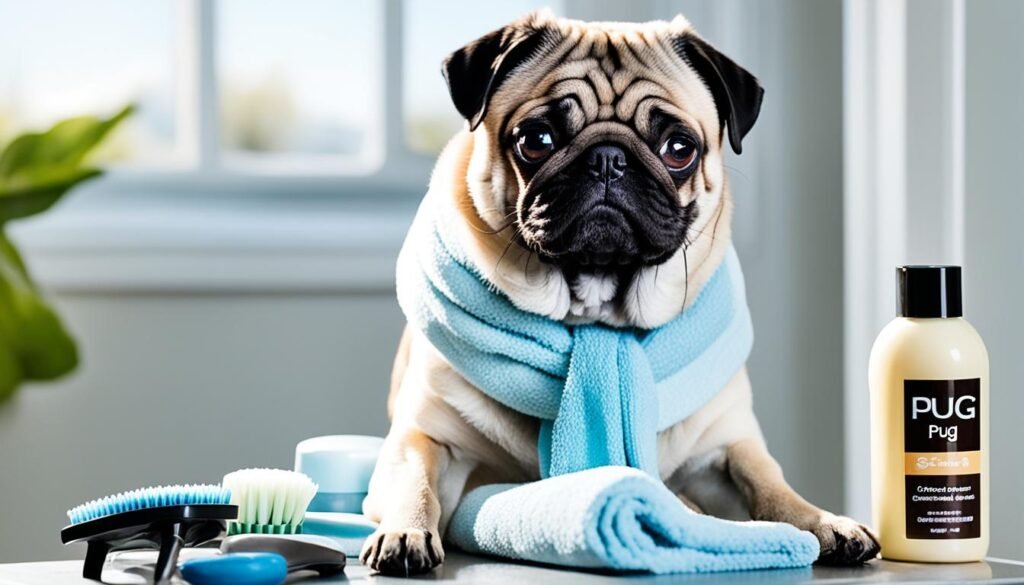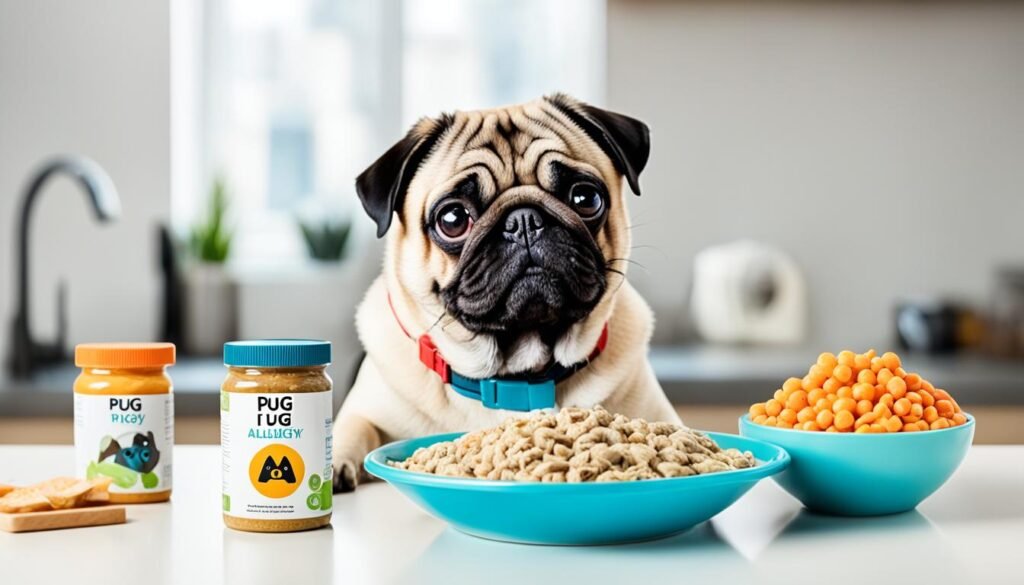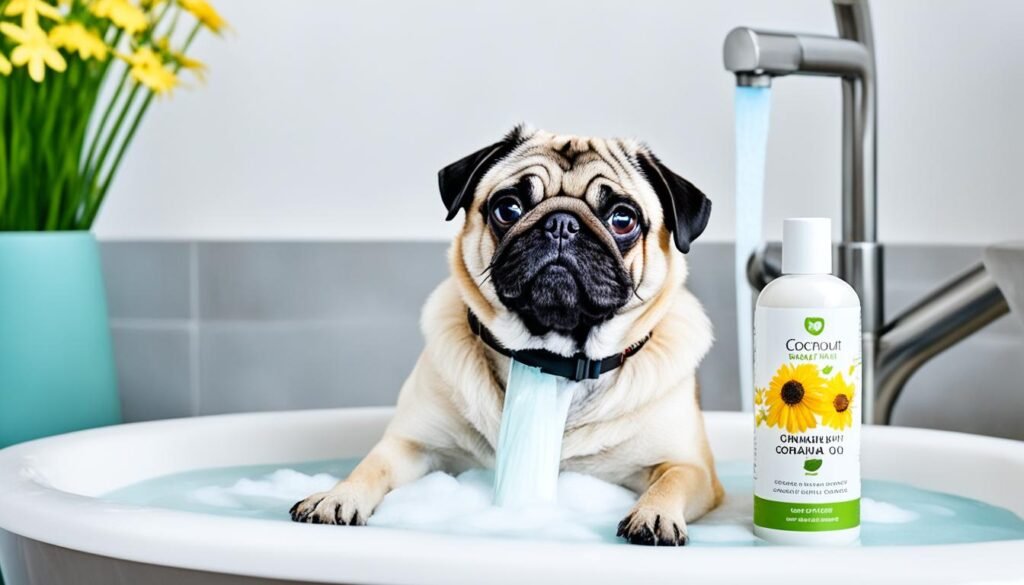How to avoid skin allergies in Pugs
As a proud Pug owner, I know how vital it is to keep our beloved pets healthy and comfy. Allergies can be tough on Pugs, just like they are on us. It’s key to know the different allergies they might get. These include things like environmental irritants, food sensitivities, and fleas.
This article will cover the various allergies Pugs can get, how to spot the signs, and how to prevent and manage them. With the right grooming, hypoallergenic products, and diet changes, we can help our Pugs stay itch-free and happy.
By knowing what triggers allergies and taking action early, we can stop our Pugs from getting skin allergies. This way, they can live a healthy, happy life. Let’s look at ways to keep our Pugs’ skin looking great and their tails wagging!
Understanding Pug Allergies
Pugs are loved pets but can face allergies that make them uncomfortable. They can have environmental allergies, food allergies, and flea allergies. It’s key to know these allergies to help your pug.
Types of Pug Allergies
Environmental allergies are the top allergy type in pugs. They can come from things like pollen, dust mites, and mold. Food allergies happen when pugs react badly to some foods. Flea allergies occur when flea bites cause an allergic reaction.
Recognizing Allergic Reactions in Pugs
Signs of allergies in pugs include a lot of scratching, biting, or licking their skin. You might also see red, inflamed skin, ear infections, and stomach problems like vomiting or diarrhea. Sneezing and breathing issues could mean they’re allergic to something outside.
Preventing Environmental Allergies in Pugs
It’s important to fight environmental allergies for our Pugs’ health. Using air purifiers and cleaning often can help. Also, keep them indoors when pollen counts are high.
Reducing Exposure to Allergens
Keeping your Pug’s space clean is key. Get a good air purifier and vacuum often. Dust and pet dander should be gone. Watch pollen levels and stay indoors when pollen is high.
Grooming and Bathing Routines
Regular grooming and baths help with allergies. Medicated shampoos and baths clean out allergens. Your vet might suggest medicine for itching and swelling. A good pug grooming and bathing routine for allergies is vital. It helps in preventing environmental allergies in pugs and reducing exposure to allergens for pugs.

How to Avoid Skin Allergies in Pugs
Keeping your pug’s skin healthy means being proactive. To prevent skin allergies, focus on environmental and dietary triggers. A good pug skin care routine is key to keeping your pet happy and free from itching.
Start by reducing your pug’s exposure to allergens. Regular grooming and using hypoallergenic products for pugs can cut down on pollen and dust. Also, choose a top-quality, hypoallergenic dog food to avoid food sensitivities.
Flea allergies are a big issue for pugs too. Using flea prevention products can help keep these pests away. If your pug gets a flea allergy, you might need special treatments to help them feel better.
Early action and a proactive approach to your pug’s skin health are crucial. With the right how to avoid skin allergies in pugs tips, your pet can live a happy, itch-free life.
Identifying Food Allergies in Pugs
If your pug has ongoing skin problems or seems uncomfortable, it might be due to food allergies. Pugs have sensitive stomachs and can react to certain foods. Finding out what food is causing the allergy can really help your pet feel better.
Elimination Diet for Pugs
Your vet might suggest an elimination diet to figure out what’s causing your pug’s allergy. This means taking all possible allergens out of their diet and then adding them back in one at a time. By trying different hypoallergenic dog food options, you can find out what’s making your pug sick and avoid it in the future.
Being patient and careful is important during an elimination diet. It might take weeks or even months to find the right food allergy. But, it’s worth it to make your pug feel better. It’s important to work with your vet to find the right diet for your pug with allergies.

Combating Flea Allergies in Pugs
Flea allergies can be a big problem for Pug owners. But, there are ways to manage them well. Using high-quality flea prevention products is key to keeping fleas away and making your Pug comfortable.
If your Pug gets flea allergy dermatitis, you need to act fast. This might mean using creams or pills to help your Pug feel better. Getting rid of fleas and their eggs is also important. This helps keep your Pug healthy and happy.
Flea Prevention and Treatment
Using vet-approved flea prevention products can really help with *combating flea allergies in pugs*. These products kill and keep fleas away, stopping allergic reactions. Cleaning your Pug’s living area well also helps in *flea prevention and treatment for pugs*. This keeps fleas away for good.
At-Home Allergy Relief for Pugs
As a pug owner, you want to give your dog the best care, especially for allergies. Luckily, there are many at-home remedies and supplements to help your pug feel better.
Supplements and Remedies
Omega-3 and omega-6 fatty acids are great for pug allergies. These nutrients make your pug’s skin healthier and reduce inflammation. Regular grooming also helps by removing allergens and preventing skin infections.
Keeping your pug at a healthy weight is key to managing pug allergies. Being overweight can strain your pug’s immune system, making allergies harder to handle. Over-the-counter antihistamines and special shampoos can help, but talk to your vet before trying them.

Adding these supplements and remedies for pug allergies to your pug’s routine can ease their discomfort. Always work with your vet to keep your pug safe and happy.
When to Seek Veterinary Care
As a responsible pug owner, knowing when to seek veterinary care for pug allergies is key. If home remedies don’t work or if your pug’s allergy symptoms that require vet visit get worse, it’s time to get professional help. A vet can run tests like blood tests or skin tests to find out what’s causing the allergies.
In some cases, your vet might suggest seeing a veterinary dermatologist for more checks and treatment. It’s important to keep up with vet care to keep your pug healthy and comfortable. If your pug’s allergies don’t get better or get worse, don’t wait to get professional advice.
Effective Treatments for Pug Skin Allergies
Managing your pug’s skin allergies depends on the cause and how bad it is. Your vet will help pick the best treatment, which might be medicines and changes in your pug’s life.
Medicines like antihistamines, corticosteroids, and immunotherapy are key in easing your pug’s allergy symptoms. Antihistamines stop histamine from causing trouble. Corticosteroids calm down the immune system’s overactive state. Immunotherapy slowly introduces your pug to the allergen, helping them get used to it over time.
If your pug has food allergies, your vet might suggest an elimination diet or a special pet food. This helps figure out what’s causing the allergies. Keeping your pug’s diet consistent and free from allergens is a great way to help their skin.

